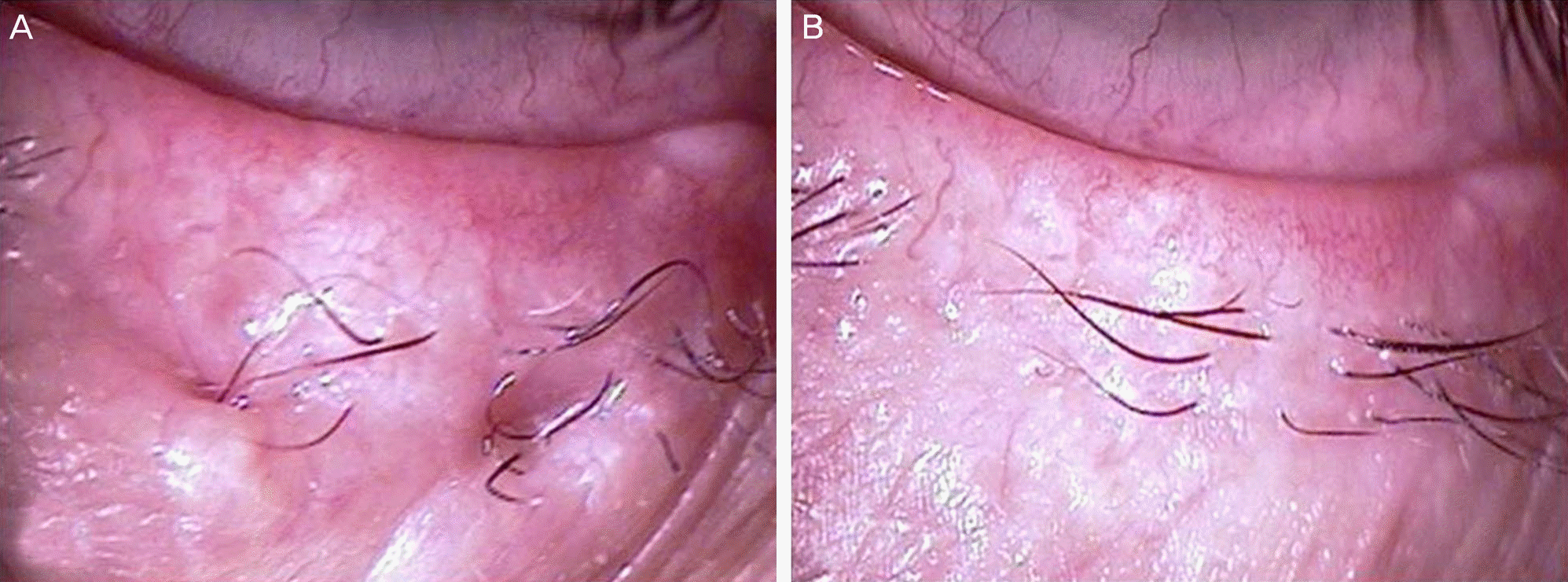Abstract
Purpose
To introduce the modified Quickert suture for lower lid entropion, using nonabsorbable suture material.
Methods
From October, 2011 to June, 2012, a total of 11 patients (12 eyes) with lower lid entropion, in poor general condition or who did not want extensive surgery, were recruited for the present surgery. Three small skin incisions were made at the medial, central, and lateral areas, just below the lower cilia. With double armed 6-0 nylon, each needle was inserted in the inferior conjuctival fornix and the 2 ends of the suture were tied and buried at the point of the skin incision site. Sutures were made at the medial, central and lateral areas.
Results
The patients consisted of 4 males and 7 females with an average age of 71.3 ± 8.4 years (54-82 years). The patients were followed up the patients for an average of 13.9 ± 2.4 months postoperatively. All patients were satisfied with the outcome, and there were no recurrences.
Conclusions
Quickert suture is a simple and effective method, for correcting lower lid entropion by inducing scar formation with absorbable suture materials, but the effect duration is limited. Because the modified Quickert suture utilizes its own tension with a nonabsorbable suture material, the effect lasts as long as the suture material remains. It is a useful and practicable method for patients, in poor general condition or not wanting extensive surgical procedures.
Go to : 
References
1. Pereira MG, Rodrigues MA, Rodrigues SA. Eyelid entropion. Semin Ophthalmol. 2010; 25:52–8.
3. Kim SW, Lee WS, Rho JH. Lateral tarsal strip procedure combined with Quickert sutures in correcting involutional entropion. J Korean Ophthalmol Soc. 2012; 53:1213–8.

4. Ahn Y, Kang IS. Correction of involutional entropion by the amount of lower eyelid laxity. J Korean Ophthalmol Soc. 1999; 40:596–602.
5. Ha JK, Kim YS, Sohn MA. Surgical treatment of sensile entropion. J Korean Ophthalmol Soc. 1998; 39:631–6.
6. Kim JY, Kim YD. Surgical correction of senile entropion. J Korean Ophthalmol Soc. 1992; 33:1015–20.
7. Bae SH, Kim MJ, Choi YJ, Kim SJ. The effect of involutional entropion surgery: Quickert-Rathbun suture. J Korean Ophthalmol Soc. 2005; 46:1103–7.
8. Kang SH, Kim YD. Management of severe cicatricial entropion using shared nasal turbinate mucosal graft. J Korean Ophthalmol Soc. 2002; 43:2335–40.
9. Goldberg RA, Joshi AR, McCann JD, Shorr N. Management of severe cicatricial entropion using shared mucosal grafts. Arch Ophthalmol. 1999; 117:1255–9.

10. Paik HJ, Lee TS. The effects of tenzel operation on cicatricial entropion. J Korean Ophthalmol Soc. 1993; 34:943–9.
11. Wright M, Bell D, Scott C, Leatherbarrow B. Everting suture correction of lower lid involutional entropion. Br J Ophthalmol. 1999; 83:1060–3.

12. Scheepers MA, Singh R, Ng J, et al. A randomized controlled trial comparing everting sutures with everting sutures and a lateral tarsal strip for involutional entropion. Ophthalmology. 2010; 117:352–5.

13. Tsang S, Yau GS, Lee JW, et al. Surgical outcome of involutional lower eyelid entropion correction using transcutaneous everting sutures in Chinese patients. Int Ophthalmol. 2014; 34:865–8.

14. Chi MJ, Park MS, Choi YJ, Baek SH. The effect of nonincisional double fold formation using three small incisions, two-stitch method. J Korean Ophthalmol Soc. 2006; 47:505–11.
Go to : 
 | Figure 1.Schematic diagram of our modified Quickert suture using non-absorbable suture material. Three small skin incisions are made (A). Cross section view of the lower eyelid. Each needle of double-armed 6-0 nylon is inserted in the inferior conjuctival fornix and the two ends of the suture are tied and buried at the point of the skin incision site (B). Quickert suture was done at the medial, central, and lateral skin incision site and the incised skin was sutured (C). |
 | Figure 2.Postoperative skin dimpling. Slit lamp photographs of a 73 years old female patient who had spastic and cicatricial (marginal) entropion because of herpetic keratoconjunctivitis. Six months after post-modified Quickert suture using non-absorbable suture material (A). Twelve months after post-modified Quickert suture using non-absorbable suture material (B). Postoperative skin dimpling gradually improved during the follow up period. |
Table 1.
Patients’ characteristics




 PDF
PDF ePub
ePub Citation
Citation Print
Print


 XML Download
XML Download